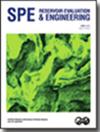A Method for Determination of Rock Fabric Number from Well Logs in Unconventional Tight Oil Carbonates
IF 1.5
4区 工程技术
Q3 ENERGY & FUELS
引用次数: 1
Abstract
Summary This paper develops a method for estimation of rock fabric number (RFN) from well logs in unconventional tight oil carbonates with permeability less than 0.1 md. The objective is to investigate the oil potential of a Middle Cretaceous tight carbonate in Mexico. The development of a method for these conditions is challenging as the current approach developed by Lucia (1983) has been explained for carbonates with permeability more than 0.1 md. Core data and drill cuttings available for this study are limited but provide important insights for the log interpretation and for identifying the presence of grainstone, packstone, and wackstone rocks in the unconventional tight carbonate under consideration. A crossplot of RFN vs. rp35 (pore throat radius at 35% cumulative pore volume) permits delimiting intervals with good production potential that are supported by well testing data. Information for the analysis of the Mexican carbonate comes from well logs of nine wells and two re-entry wells, four buildup tests, and a limited amount of core and drill cuttings information. All data were provided by a petroleum company and have been used, for transparency, without any modifications. An unconventional tight carbonate as defined in this paper has a permeability smaller than 0.1 md. The unconventional tight oil carbonate reservoir considered in this study includes 95% of data with permeabilities smaller than 0.1 md and only 5% with permeabilities larger than 0.1 md. The method introduced by Lucia (1983) and Jennings and Lucia (2003) for determining RFN is powerful, but they explained it only for permeabilities larger than 0.1 md, thus the need for a methodology that allows estimating from well logs the presence of grainstone, packstone, and/or wackstone in unconventional tight carbonate reservoirs with permeabilities smaller than 0.1 md. Results indicate that the RFN provides a useful approach for distinguishing grainstone, packstone, and wackstone rocks in unconventional tight carbonate reservoirs. Furthermore, rock fabric can be linked with Pickett plots to provide an integrated quantitative evaluation of RFN, porosity, water saturation, permeability, pore throat radius, and capillary pressure. This integration indicates that there is good oil potential in the Middle Cretaceous unconventional tight carbonate in Mexico.非常规致密油碳酸盐岩测井资料中岩石组构数的确定方法
本文开发了一种从渗透率小于0.1 md的非常规致密油碳酸盐岩测井资料中估计岩石织构数(RFN)的方法,目的是研究墨西哥中白垩统致密碳酸盐岩的石油潜力。由于Lucia(1983)目前开发的方法仅适用于渗透率超过0.1 md的碳酸盐岩,因此开发一种适用于这些条件的方法具有挑战性。本研究可用的岩心数据和钻屑有限,但为测井解释和识别非常规致密碳酸盐岩中颗粒岩、包层岩和碎屑岩的存在提供了重要的见解。RFN与rp35(累积孔隙体积为35%时的孔喉半径)的交叉图可以根据试井数据确定具有良好生产潜力的层段。墨西哥碳酸盐岩的分析信息来自于9口井和2口再入井的测井资料、4口堆积测试以及有限的岩心和钻屑信息。所有数据都是由一家石油公司提供的,为了透明起见,这些数据没有经过任何修改。本文定义的非常规致密碳酸盐岩渗透率小于0.1 md。本研究考虑的非常规致密油碳酸盐岩储层包括95%的渗透率小于0.1 md的数据,只有5%的渗透率大于0.1 md的数据。Lucia(1983)和Jennings和Lucia(2003)引入的确定RFN的方法很强大,但他们只解释了渗透率大于0.1 md的方法。因此,对于渗透率小于0.1 md的非常规致密碳酸盐岩储层,需要一种能够从测井资料中估计颗粒岩、包覆岩和/或碎屑岩是否存在的方法。结果表明,RFN为区分非常规致密碳酸盐岩储层中的颗粒岩、包覆岩和碎屑岩提供了一种有用的方法。此外,岩石组构可以与Pickett图联系起来,提供RFN、孔隙度、含水饱和度、渗透率、孔喉半径和毛管压力的综合定量评价。这表明墨西哥中白垩统非常规致密碳酸盐岩具有良好的成藏潜力。
本文章由计算机程序翻译,如有差异,请以英文原文为准。
求助全文
约1分钟内获得全文
求助全文
来源期刊
CiteScore
5.30
自引率
0.00%
发文量
68
审稿时长
12 months
期刊介绍:
Covers the application of a wide range of topics, including reservoir characterization, geology and geophysics, core analysis, well logging, well testing, reservoir management, enhanced oil recovery, fluid mechanics, performance prediction, reservoir simulation, digital energy, uncertainty/risk assessment, information management, resource and reserve evaluation, portfolio/asset management, project valuation, and petroleum economics.

 求助内容:
求助内容: 应助结果提醒方式:
应助结果提醒方式:


